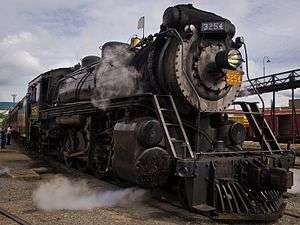Canadian National 3254
Canadian National 3254 is a class "S-1-b" 2-8-2 "Mikado" type steam locomotive built in 1917 for the Canadian National Railway by the Canadian Locomotive Company as a member of the Canadian National class S-1-b. It used to be a part of the operating fleet at the Steamtown National Historic Site in Scranton, Pennsylvania until being indefinitely retired from excursion service in 2012 due to serious frame issues, being replaced by Boston and Maine 4-6-2 #3713 as part of Steamtown's operating fleet for use on excursion trains.
| Canadian National 3254 | |||||||||||||||||||||||||||||||||||
|---|---|---|---|---|---|---|---|---|---|---|---|---|---|---|---|---|---|---|---|---|---|---|---|---|---|---|---|---|---|---|---|---|---|---|---|
 CN No. 3254 in June 2011 | |||||||||||||||||||||||||||||||||||
| |||||||||||||||||||||||||||||||||||
| |||||||||||||||||||||||||||||||||||
| |||||||||||||||||||||||||||||||||||
| |||||||||||||||||||||||||||||||||||
History
Canadian National 3254 was built in 1917 by the Canadian Locomotive Company for the Canadian Government Railways where it was numbered 2854. In 1918, the Canadian Government Railways combined with the Canadian Northern Railway formed the Canadian National Railways. The 3254 had considerable pulling power, could climb grades with ease,[1] and was used to handle very heavy freight trains until the Canadian National retired it in 1958.
In November, 1961 it was sold to motel owner Willis F. Barron who moved it to Ashland, Pennsylvania and intended to run the locomotive on the Reading Company's branchline that served the town. The tracks into Ashland were pulled up before Barron's planned venture could begin operation, so he had 3254 disassembled, moved via truck and reassembled at his motel to be used as a static display.[2] In 1982 it was sold to the Gettysburg Railroad. In the summer of 1987, the steam locomotive arrived at Steamtown National Historic Site after they traded Canadian Pacific 4-6-2 #1278 and some extra cash for the 3254.[1]
Steamtown also has a Canadian National class S-1-d "Mikado", the 3377, on static display. Unfortunately, the 3377 was the target of copper thieves during her trip to Steamtown. The locomotive was never repaired and therefore became a source parts for 3254,[3][4] including the tender, which replaced the 3254's tender in 2010 due to rust leaks.
As a result of issues with either the boiler/firebox or the frame, combined with other needed maintenance which made further operation impractical, 3254 was taken out of service indefinitely after the 2012 season. The early retirement is likely attributed to a collision sustained at some point during her service life - her frame horns are bent and the frame is also bowed to one side, causing the cab to sit off-center. She has frequently been described as a "rough rider," and had been chewing up bearings at an accelerated rate. As a result, 3254 will soon be replaced by Boston and Maine 4-6-2 #3713 as part of Steamtown's operating fleet for use on excursion trains.
References
- "Steamtown National Historic Site - Canadian National 3254 (U.S. National Park Service)". Retrieved June 26, 2010.
- http://www.cr.nps.gov/history/online_books/steamtown/shs3b.htm
- "RailPictures.Net Photo: Canadian National Railway Steam 2-8-2 at Scranton, Pennsylvania by Dennis A. Livesey-liveseyimages.com". Retrieved 2010-07-27.
- "Canadian National 2-8-2s". Retrieved 2010-07-27.